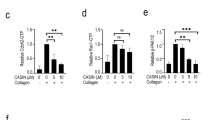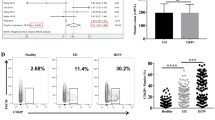Abstract
Poly (ADP-ribose) glycohydrolase (PARG), which was discovered during studies on DNA damage study and in inflammation research, is an attractive target protein in current cancer research. The enzymatic hydrolysis of poly (ADP-ribose) (PAR) has not been clarified in the regulation of cancer. The purpose of this study was to understand the relationship between PARG and the adhesion of colorectal carcinoma CT26 cells to platelets. PARG was silenced by short hairpin RNA (shRNA) transfection in CT26 cells. A fluorescence method was used to identify adhesion of CT26 cells to platelets and the expression of poly (ADP-ribose) polymerase (PARP)-1, p-Akt, nuclear factor kappa-B (NF-κB), P-selectin and intercellular adhesion molecule-1 (ICAM-1) was analyzed by western blot in various treated groups and control groups. The results were as follows: (a) PARG silencing led to inhibition of adhesion of CT26 cells to platelets, whereas an inhibitor of p-Akt boosted adhesion of PARG-short hairpin RNA interference (shRNAi) CT26 cells to platelets; (b) a PARP-1 inhibitor depressed the expression of P-selectin and ICAM-1 in CT26 cells; (c) PARG silencing increased phosphorylation of Akt and decreased expression of PARP-1, NF-κB, ICAM-1 and P-selectin in CT26 cells; and (d) a p-Akt inhibitor intensified expression of NF-κB, ICAM-1 and P-selectin in PARG-shRNAi CT26 cells accordingly. These results showed the effectiveness of knockout of PARG in inhibiting adhesion of CT26 cells to platelets and its connection with the phosphatidylinositol 3 kinase/Akt pathway.
This is a preview of subscription content, access via your institution
Access options
Subscribe to this journal
Receive 12 print issues and online access
$259.00 per year
only $21.58 per issue
Buy this article
- Purchase on Springer Link
- Instant access to full article PDF
Prices may be subject to local taxes which are calculated during checkout





Similar content being viewed by others
References
Bonicalzi M-E, Haince J-F, Droit A, Poirier GG . Regulation of poly(ADP-ribose) metabolism by poly(ADP-ribose) glycohydrolase: where and when? Cell Mol Life Sci 2005; 62: 739–750.
Min W, Wang ZQ . Poly (ADP-ribose) glycohydrolase (PARG) and its therapeutic potential. Front Biosci 2009; 14: 1619–1626.
Sun Y, Zhang T, Wang B, Li H, Li P . Tannic acid, an inhibitor of poly(ADP-ribose) glycohydrolase, sensitizes ovarian carcinoma cells to cisplatin. Anticancer Drugs 2012; 23: 979–990.
Erdélyi K, Bai P, Kovács I, Szabó E, Mocsár G, Kakuk A et al. Dual role of poly(ADP-ribose) glycohydrolase in the regulation of cell death in oxidatively stressed A549 cells. FASEB J 2009; 23: 3553–3563.
Keil C, Gröbe T, Oei SL . MNNG-induced cell death is controlled by interactions between PARP-1, poly(ADP-ribose) glycohydrolase, and XRCC1. J Biol Chem 2006; 281: 34394–34405.
Fisher AEO, Hochegger H, Takeda S, Caldecott KW . Poly(ADP-ribose) polymerase 1 accelerates single-strand break repair in concert with poly(ADP-ribose) glycohydrolase. Mol Cell Biol 2007; 27: 5597–5605.
Frizzell KM, Gamble MJ, Berrocal JG, Zhang T, Krishnakumar R, Cen Y et al. Global analysis of transcriptional regulation by poly(ADP-ribose) polymerase-1 and poly(ADP-ribose) glycohydrolase in MCF-7 human breast cancer cells. J Biol Chem 2009; 284: 33926–33938.
Fauzee NJ, Li Q, Wang YL, Pan J . Silencing poly (ADP-ribose) glycohydrolase (PARG) expression inhibits growth of human colon cancer cells in vitro via PI3K/Akt/NF?-B pathway. Pathol Oncol Res 2012; 18: 191–199.
Hao LX, Wang YL, Li YY . Correlation of PARP expression with P-selectin and ICAM-1 expression in colorectal carcinoma. Basic Med Sci Clin 2008; 26: 882–887.
Frenette PS, Denis CV, Weiss L, Jurk K, Subbarao S, Kehrel B et al. P-selectin glycoprotein ligand 1 (PSGL-1) is expressed on platelets and can mediate platelet–endothelial interactions in vivo. J Exp Med 2000; 191: 1413–1422.
Stone JP, Wagner DD . P-selectin mediates adhesion of platelets to neuroblastoma and small cell lung cancer. J Clin Invest 1993; 92: 804–813.
Nair KS, Naidoo R, Chetty R . Expression of cell adhesion molecules in oesophageal carcinoma and its prognostic value. J Clin Pathol 2005; 58: 343–351.
Kim JE, Lee S, Han KS . Aurintricarboxylic acid inhibits the nuclear factor-κB-dependent expression of intercellular cell adhesion molecule-1 and endothelial cell selectin on activated human endothelial cells. Blood Coagul Fibrinolysis 2011; 22: 132–139.
Biggerstaff JP, Seth N, Amirkhosravi A, Amaya M, Fogarty S, Meyer TV et al. Soluble fibrin augments platelet/tumor cell adherence in vitro and in vivo, and enhances experimental metastasis. Clin Exp Metastasis 1999; 17: 723–730.
McCaffery PJ, Berridge MV . Expression of the leukocyte functional molecule (LFA-1) on mouse platelets. Blood 1986; 67: 1757–1764.
Li B, Cheung PY, Wang X, Tsao SW, Ling MT, Wong YC et al. Id-1 activation of PI3K/Akt/NFκB signaling pathway and its significance in promoting survival of esophageal cancer cells. Carcinogenesis 2007; 28: 2313–2320.
Asano T, Yao Y, Zhu J, Li D, Abbruzzese JL, Reddy SAG . The PI 3-kinase/Akt signaling pathway is activated due to aberrant Pten expression and targets transcription factors NF-κB and c-Myc in pancreatic cancer cells. Oncogene 2004; 23: 8571–8580.
Shinohara M, Chung YJ, Saji M, Ringel MD . AKT in thyroid tumorigenesis and progression. Endocrinol 2007; 148: 942–947.
Crowell JA, Steele VE, Fay JR . Targeting the AKT protein kinase for cancer chemoprevention. Mol Cancer Ther 2007; 6: 2139–2148.
Kane LP, Shapiro VS, Stokoe D, Weiss A . Induction of NF-κB by the Akt/PKB kinase. Curr Biol 1999; 9: 601–604.
Romashkova JA, Makarov SS . NF-κB is a target of AKT in anti-apoptotic PDGF signalling. Nature 1999; 401: 86–90.
Wang Y, Wang X, Sun M, Zhang Z, Cao H, Chen X . NF-kB activity-dependent P-selectin involved in ox-LDL-induced foam cell formation in U937 cell. Biochem Biophys Res Commun 2011; 411: 543–548.
Melotti P, Nicolis E, Tamanini A, Rolfini R, Pavirani A, Cabrini G . Activation of NF-κB mediates ICAM-1 induction in respiratory cells exposed to an adenovirus-derived vector. Gene Ther 2001; 8: 1436–1442.
Tapodi A, Debreceni B, Hanto K, Bognar Z, Wittmann I, Gallyas F et al. Pivotal role of Akt activation in mitochondrial protection and cell survival by poly(ADP-ribose)polymerase-1 inhibition in oxidative stress. J Biol Chem 2005; 280: 35767–35775.
García S, Mera A, Gómez-Reino JJ, Conde C . Poly(ADP-ribose) polymerase suppression protects rheumatoid synovial fibroblasts from Fas-induced apoptosis. Rheumatol 2009; 48: 483–489.
Veres B, Radnai B, Gallyas F, Varbiro G, Berente Z, Osz E et al. Regulation of kinase cascades and transcription factors by a poly(ADP-ribose) polymerase-1 inhibitor, 4-hydroxyquinazoline, in lipopolysaccharide-induced inflammation in mice. J Pharmacol Exp Ther 2004; 310: 247–255.
Fuster MM, Brown JR, Wang L, Esko JD . A disaccharide precursor of sialyl Lewis X inhibits metastatic potential of tumor cells. Cancer Res 2003; 63: 2775–2781.
Kim YJ, Borsig L, Varki NM, Varki A . P-selectin deficiency attenuates tumor growth and metastasis. Proc Natl Acad Sci USA 1998; 95: 9325–9330.
Verheul H, Jorna AS, Hoekman K, Broxterman HJ, Gebbink M, Pinedo HM . Vascular endothelial growth factor-stimulated endothelial cells promote adhesion and activation of platelets. Blood 2000; 96: 4216–4221.
Shau H, Roth MD, Golub SH . Regulation of natural killer function by non-lymphoid cells. Nat Immunol 1993; 12: 235–249.
Li Q, Li M, Wang YL, Fauzee NJ, Yang Y, Pan J et al. RNA interference of PARG could inhibit the metastatic potency of colorectal carcinoma cells via PI3-kinase/Akt pathway. Cell Physiol Biochem 2012; 29: 361–372.
Rapizzi E, Fossati S, Moroni F, Chiarugi A . Inhibition of poly(ADP-ribose) glycohydrolase by gallotannin selectively up-regulates expression of proinflammatory Genes. Mol Pharmacol 2004; 66: 890–898.
Veto S, Acs P, Bauer J, Lassmann H, Berente Z, Setalo G et al. Inhibiting poly(ADP-ribose) polymerase: a potential therapy against oligodendrocyte death. Brain 2010; 133: 822–834.
Bartha E, Solti I, Kereskai L, Lantos J, Plozer E, Magyar K et al. PARP inhibition delays transition of hypertensive cardiopathy to heart failure in spontaneously hypertensive rats. Cardiovasc Res 2009; 83: 501–510.
Li M, Threadgill MD, Wang Y, Cai L, Lin X . Poly(ADP-ribose) polymerase inhibition down-regulates expression of metastasis-related genes in CT26 colorectal carcinoma cells. Pathobiology 2009; 76: 108–116.
Rane MJ, Song Y, Jin S, Barati MT, Wu R, Kausar H et al. Interplay between Akt and p38 MAPK pathways in the regulation of renal tubular cell apoptosis associated with diabetic nephropathy. Am J Physiol Renal Physiol 2010; 298: F49–F61.
Pan J, Fauzee NJ, Wang YL, Sheng YT, Tang Y, Wang JQ et al. Effect of silencing PARG in human colorectal carcinoma LoVo cells on the ability of HUVEC migration and proliferation. Cancer Gene Ther 2012; 19: 715–722.
Cuzzocrea S, Mazzon E, Genovese T, Crisafulli C, Min WK, Di Paola R et al. Role of poly(ADP-ribose) glycohydrolase in the development of inflammatory bowel disease in mice. Free Radic Biol Med 2007; 42: 90–105.
Acknowledgements
We thank Lin Xiao and Bu You-Quan for excellent technical help. This work was supported by the National Nature Science Foundation of China (NSFC: 30870946).
Author information
Authors and Affiliations
Corresponding author
Ethics declarations
Competing interests
The authors declare no conflict of interest.
Rights and permissions
About this article
Cite this article
Yan, J., Li, M., Threadgill, M. et al. Decreasing P-selectin and ICAM-1 via activating Akt: a possible mechanism by which PARG inhibits adhesion of mouse colorectal carcinoma CT26 cells to platelets. Cancer Gene Ther 20, 487–492 (2013). https://doi.org/10.1038/cgt.2013.44
Received:
Revised:
Accepted:
Published:
Issue Date:
DOI: https://doi.org/10.1038/cgt.2013.44



